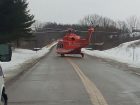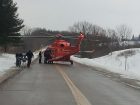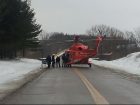
Features
Structural
Training
Back to Basics: August 2018
Not too many departments get the chance to work with air ambulance very often, so when they do it is often a new thing for them. This article was written right after an incident occurred which required air ambulance to attend.
July 16, 2018
By Mark van der Feyst
It was a diversion from the basics of firefighting but highlighted some of the important safety factors that they needed to be aware of.
■ Helicopter Safety: May 2012
In February, around 10:30 a.m., the author responded to a call for a vehicle accident. Updated information given on route told us that the vehicle had collided with a train at a land railway crossing. On arrival, we confirmed a single vehicle involved with a train. The vehicle had been hit very hard and the collision caused it to bounce off a few rail cars, travelling down the rail line about 40 feet. The vehicle rested on the rail line embankment with a portion under the rail car.
Inside the vehicle was a lone occupant in the driver’s seat sustaining visual facial and head trauma. Initial reports indicated that the driver was trapped with his feet and legs pinned under the dash. Upon initial survey of the vehicle, it was discovered that the driver’s legs were not pinned and were able to move freely out of the vehicle. A hoseline was pulled off the apparatus and charged to provide water protection for the responding crew members. Any vehicle accident will have fluids leaking from the vehicles involved and can lead to a fire being created from sparks or another ignition source. This vehicle accident had plenty of gasoline, diesel and other car fluids on the ground around where personnel were working. Extrication equipment was also removed from the apparatus and placed at a staging area near the vehicle.
Upon arrival of EMS, an assessment was conducted by the paramedics and site supervisor to determine the extent and nature of the injuries. Seeing as the vehicle collided with a train at a high rate of speed, serious internal injuries were suspected. This prompted EMS to request an air ambulance to respond to the scene. See photo 1.
No matter where you are located in Canada, or what type and size fire department you work for, there is a good chance you may have to deal with an air ambulance responding to your scene and land. When this occurs, there are some important safety factors that need to be remembered and implemented in order to keep everyone on scene safe. The air ambulance service trains regularly with the fire service to ensure personnel are familiar with the protocols for landing and working around an air ambulance. It might be a good idea to contact them to set up a training time as part of a yearly training plan.
When the air ambulance arrives near the scene, they will conduct a scene survey of their own. This will involve a low circular flight pattern over the incident scene. This is done to determine if the landing zone is the appropriate size, if there are no immediate hazards in the vicinity (such as electrical wires) and also to let everybody on scene know that they are coming down soon. An appropriate landing zone is recommended to be 150 feet by 150 feet. This size of landing zone allows for a large helicopter to land safely. The ground needs to be solid, such as asphalt pavement or concrete roadways, so that the helicopter will not sink into it when it lands. If the pilot determines that the landing zone is not adequate, they will choose one of their liking.
The pilot will be in constant communication with a landing zone officer prior to landing. This person can be any firefighter, police or EMS personnel. If chosen for this task, be sure to communicate clearly and effectively with the pilot. You will need to identify yourself as the landing zone officer to the pilot so that they know who they are speaking with. Give precise directions of the landing zone and observations to the pilot as they are landing so that they know exactly what they are dealing with on the ground. Observations can include landmarks around the landing area, overhead hazards and wind direction.
Prior to the helicopter landing, all loose debris needs to be picked up and secured or else it becomes a projectile. This includes an uncharged hoseline, equipment from the fire apparatus lying on the ground, and any objects that are small. Any projectile can easily cause injuries to responding personnel on scene as well as cause mechanical damage to the helicopter’s engines when the debris is sucked into the engine intakes.
When the helicopter is landing, there will be a production of downwash from the rotors. The downwash produced can be as fast as 100 miles per hour or 160 kilometres per hour, blowing anything in its path. Protection of the eyes needs to take place with either wearing safety glasses or turning away until the helicopter has landed. At our accident scene, when the helicopter was landing, snow was being blown around producing a whiteout condition. All personnel had to turn away momentarily to prevent flying snow particles from entering their eyes. The same is true when it comes time for the helicopter to take off.
Another safety factor to implement is remaining a safe distance away from the helicopter. When the helicopter is landing and on the ground, a safe distance of 200 feet is recommended for all personnel and 150 feet for vehicles. This safe distance needs to be maintained until you are directed to approach the helicopter by the pilot or a crew member. If you need to approach the helicopter, always have direct line of sight with the pilot and make sure that he or she sees you.
If you are assisting EMS with patient transfer to the helicopter, a crew member will escort you to the helicopter. In photo 2, you can see the crew member in the white flight helmet. They will ensure that it is safe to approach, escort you to the helicopter and then direct you away from the helicopter when it comes time to leave.
In photo 3, you can see two EMS personnel departing away from the helicopter. Notice how they are positioned. They are hunched down while walking under the canopy of the rotating blades. The blades of the helicopter are the most dangerous part for any personnel approaching. As they spin, they look invisible but are very real and present. Walking upright will only expose your head to the blades which will only produce bad results for you.
Once on the ground, the helicopter will sometimes keep the engine running and the blades spinning at idle speed so that a quick departure can be accomplished. When this is the case, you will need to protect your head, literally by staying low when approaching the helicopter.
Always approach the helicopter from the sides directly and not along the tail portion. The rear and front areas are the more dangerous zones because the pilot cannot see you in the rear and the blades are tilted forward in the front leaving not much room to approach. There is also a spinning tail rotor in the rear.
More information about helicopter safety can be obtained from your local provider of air ambulance. They will sometimes even offer practical training to personnel so that they become comfortable and confident with working around a helicopter.
Mark van der Feyst has been a member of the fire service since 1999 and is a full-time firefighter in Ontario. Mark teaches in Canada, United States and India, and is a FDIC Instructor. He is the lead author of the Residential Fire Rescue book. Email Mark at Mark@FireStarTraining.com.
Print this page


